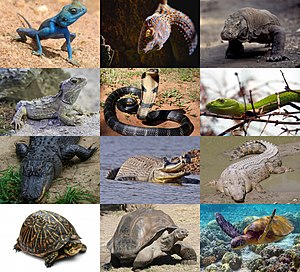
Back Reptiel Afrikaans Reptilien ALS ተሳቢ እንስሳ Amharic Reptilia AN सरिसृप ANP زواحف Arabic زواحف ARZ সৰীসৃপ Assamese Reptilia AST Sürünənlər Azerbaijani
| Reptiles Temporal range: Pennsylvanian–Present,
| |
|---|---|
 | |
| Reptilians by saurian clade listed in top-to-bottom order: six lepidosaurs and six archelosaurs. | |
| Scientific classification | |
| Domain: | Eukaryota |
| Kingdom: | Animalia |
| Phylum: | Chordata |
| Clade: | Sauropsida |
| Class: | Reptilia Laurenti, 1768 |
| Extant groups | |
See text for extinct groups. | |
Reptiles, as commonly defined, are a group of tetrapods with an ectothermic ('cold-blooded') metabolism and amniotic development. Living reptiles comprise four orders: Testudines (turtles), Crocodilia (crocodilians), Squamata (lizards and snakes), and Rhynchocephalia (the tuatara). As of May 2023, about 12,000 living species of reptiles are listed in the Reptile Database.[1] The study of the traditional reptile orders, customarily in combination with the study of modern amphibians, is called herpetology.
Reptiles have been subject to several conflicting taxonomic definitions.[2] In Linnaean taxonomy, reptiles are gathered together under the class Reptilia (/rɛpˈtɪliə/ rep-TIL-ee-ə), which corresponds to common usage. Modern cladistic taxonomy regards that group as paraphyletic, since genetic and paleontological evidence has determined that birds (class Aves), as members of Dinosauria, are more closely related to living crocodilians than to other reptiles, and are thus nested among reptiles from an evolutionary perspective. Many cladistic systems therefore redefine Reptilia as a clade (monophyletic group) including birds, though the precise definition of this clade varies between authors.[3][2] Others prioritize the clade Sauropsida, which typically refers to all amniotes more closely related to modern reptiles than to mammals.[3]
The earliest known proto-reptiles originated around 312 million years ago during the Carboniferous period, having evolved from advanced reptiliomorph tetrapods which became increasingly adapted to life on dry land. The earliest known eureptile ("true reptile") was Hylonomus, a small and superficially lizard-like animal. Genetic and fossil data argues that the two largest lineages of reptiles, Archosauromorpha (crocodilians, birds, and kin) and Lepidosauromorpha (lizards, and kin), diverged during the Permian period.[4] In addition to the living reptiles, there are many diverse groups that are now extinct, in some cases due to mass extinction events. In particular, the Cretaceous–Paleogene extinction event wiped out the pterosaurs, plesiosaurs, and all non-avian dinosaurs alongside many species of crocodyliforms, and squamates (e.g., mosasaurs). Modern non-bird reptiles inhabit all the continents except Antarctica.
Reptiles are tetrapod vertebrates, creatures that either have four limbs or, like snakes, are descended from four-limbed ancestors. Unlike amphibians, reptiles do not have an aquatic larval stage. Most reptiles are oviparous, although several species of squamates are viviparous, as were some extinct aquatic clades[5] – the fetus develops within the mother, using a (non-mammalian) placenta rather than contained in an eggshell. As amniotes, reptile eggs are surrounded by membranes for protection and transport, which adapt them to reproduction on dry land. Many of the viviparous species feed their fetuses through various forms of placenta analogous to those of mammals, with some providing initial care for their hatchlings. Extant reptiles range in size from a tiny gecko, Sphaerodactylus ariasae, which can grow up to 17 mm (0.7 in) to the saltwater crocodile, Crocodylus porosus, which can reach over 6 m (19.7 ft) in length and weigh over 1,000 kg (2,200 lb).
- ^ "Reptile Database News". reptile-database.org. Retrieved 2022-05-25.
- ^ a b Cite error: The named reference
modestoanderson2004was invoked but never defined (see the help page). - ^ a b Cite error: The named reference
Gauthier-1994-Prothero-Schochwas invoked but never defined (see the help page). - ^ Ezcurra, M.D.; Scheyer, T.M.; Butler, R.J. (2014). "The origin and early evolution of Sauria: Reassessing the Permian saurian fossil record and the timing of the crocodile-lizard divergence". PLOS ONE. 9 (2): e89165. Bibcode:2014PLoSO...989165E. doi:10.1371/journal.pone.0089165. PMC 3937355. PMID 24586565.
- ^ Sander, P. Martin (2012). "Reproduction in early amniotes". Science. 337 (6096): 806–808. Bibcode:2012Sci...337..806S. doi:10.1126/science.1224301. PMID 22904001. S2CID 7041966.
© MMXXIII Rich X Search. We shall prevail. All rights reserved. Rich X Search